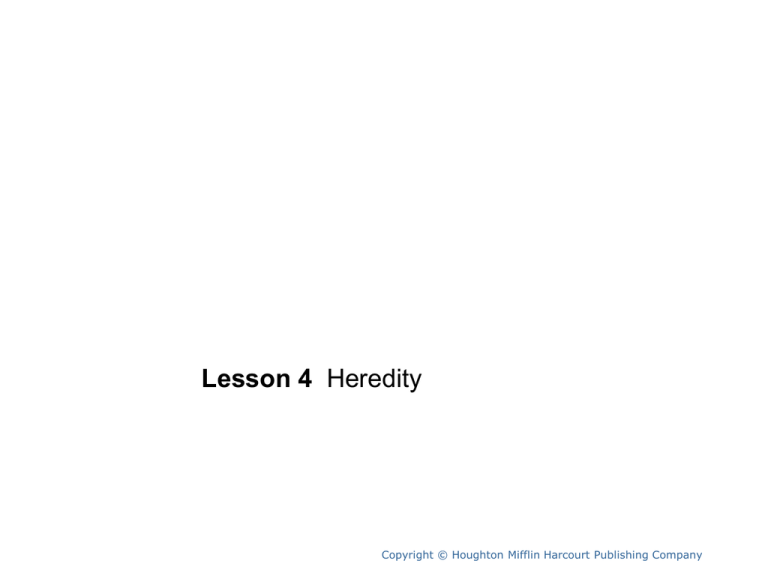6-1_CFLAEAS493558_U06L04.ppt
advertisement

Unit 6 Lesson 4 Heredity Copyright © Houghton Mifflin Harcourt Publishing Company Unit 6 Lesson 4 Heredity Florida Benchmarks • SC.7.L.16.1 Understand and explain that every organism requires a set of instructions that specifies its traits, that this hereditary information (DNA) contains genes located in the chromosomes of each cell, and that heredity is the passage of these instructions from one generation to another. • HE.6.C.1.4 Recognize how heredity can affect personal health. Copyright © Houghton Mifflin Harcourt Publishing Company Unit 6 Lesson 4 Heredity Give Peas a Chance What is heredity? • Traits, such as hair color, result from the information stored in genetic material. • Heredity is the passing of genetic material from parents to offspring. Copyright © Houghton Mifflin Harcourt Publishing Company Unit 6 Lesson 4 Heredity What did Gregor Mendel discover about heredity? • Gregor Mendel was an Austrian monk. In the 1800s, Mendel did the first major experiments in heredity. • Mendel studied seven characteristics of pea plants. • A characteristic is a feature that has different forms in a population. Copyright © Houghton Mifflin Harcourt Publishing Company Unit 6 Lesson 4 Heredity What did Gregor Mendel discover about heredity? • The seven different characteristics Mendel studied were plant height, flower and pod position, seed shape, seed color, pod shape, pod color, and flower color. • Each characteristic had two different forms. These different forms are called traits. Copyright © Houghton Mifflin Harcourt Publishing Company Unit 6 Lesson 4 Heredity What did Gregor Mendel discover about heredity? • Mendel always started with plants that were truebreeding. • True-breeding plants always produce offspring with the same characteristic if allowed to selfpollinate naturally. Copyright © Houghton Mifflin Harcourt Publishing Company Unit 6 Lesson 4 Heredity What did Gregor Mendel discover about heredity? • Mendel crossed plants that were true-breeding for producing yellow seed pods with plants that were true-breeding for green seed pods. • All of the plants from the first generation produced green seed pods. • Mendel called the green seed pod the dominant trait, and the yellow seed pods the recessive trait. Copyright © Houghton Mifflin Harcourt Publishing Company Unit 6 Lesson 4 Heredity What did Gregor Mendel discover about heredity? • Next, Mendel let the first generation plants selfpollinate. • Out of the generation that resulted, called the second generation, about three-fourths had green seed pods and one-fourth had yellow pods. Copyright © Houghton Mifflin Harcourt Publishing Company Unit 6 Lesson 4 Heredity What did Gregor Mendel discover about heredity? • The recessive trait had seemed to disappear in the first generation, but it reappeared in the second generation. Copyright © Houghton Mifflin Harcourt Publishing Company Unit 6 Lesson 4 Heredity What did Gregor Mendel discover about heredity? • Mendel hypothesized that each plant must have two heritable “factors” for each trait, one from each parent. • Some traits, such as yellow color, could only be observed if a plant had two of the same factors. • A plant with two different factors would show the dominant factor but be able to pass on both factors to its offspring. Copyright © Houghton Mifflin Harcourt Publishing Company Unit 6 Lesson 4 Heredity It’s in your genes! How are traits inherited? • Mendel’s ideas can be even further explained by our modern understanding of DNA. • What Mendel called “factors” are actually segments of DNA known as genes. Copyright © Houghton Mifflin Harcourt Publishing Company Unit 6 Lesson 4 Heredity How are traits inherited? • Genes are segments of DNA. They give instructions for producing a certain characteristic. Copyright © Houghton Mifflin Harcourt Publishing Company Unit 6 Lesson 4 Heredity How are traits inherited? • The offspring has two versions of the same gene for every characteristic—one from each parent. • Different versions of a gene are known as alleles. • Dominant alleles are shown with a capital letter, and recessive alleles are shown with a lowercase version of the same letter. Copyright © Houghton Mifflin Harcourt Publishing Company Unit 6 Lesson 4 Heredity How are traits inherited? • An organism with one dominant and one recessive allele for a gene is heterozygous for that gene. • An organism with two of the same alleles for a gene is homozygous for that gene. Copyright © Houghton Mifflin Harcourt Publishing Company Unit 6 Lesson 4 Heredity How are traits inherited? • The combination of alleles that you inherited from your parents is your genotype. • Your observable traits make up your phenotype. • The phenotypes of some traits follow patterns similar to the ones Mendel discovered. Copyright © Houghton Mifflin Harcourt Publishing Company Unit 6 Lesson 4 Heredity How are traits inherited? • The dominant allele contributes to the phenotype if one or two copies are present in the genotype. • The recessive allele contributes to the phenotype only when two copies of it are present. Copyright © Houghton Mifflin Harcourt Publishing Company Unit 6 Lesson 4 Heredity How are traits inherited? • If one chromosome in the pair contains a dominant allele and the other contains a recessive allele, the dominant allele determines the phenotype. • This is called complete dominance. Copyright © Houghton Mifflin Harcourt Publishing Company Unit 6 Lesson 4 Heredity How are traits inherited? • Some characteristics are a result of several genes acting together. • Sometimes, one gene influences more than one trait. • For example, many genetic disorders, such as sickle-cell anemia, are linked to a single gene but affect many traits. Copyright © Houghton Mifflin Harcourt Publishing Company Unit 6 Lesson 4 Heredity How are traits inherited? • Sometimes, the environment can influence an organism’s phenotype. • Some traits are acquired only from one’s environment and are not inherited. • For example, your ability to read and write is an acquired trait. Copyright © Houghton Mifflin Harcourt Publishing Company Unit 6 Lesson 4 Heredity Bending the Rules What are the exceptions to complete dominance? • Some traits do not follow the pattern of complete dominance. • For traits that show incomplete dominance and codominance, one trait is not completely dominant over another. Copyright © Houghton Mifflin Harcourt Publishing Company Unit 6 Lesson 4 Heredity What are the exceptions to complete dominance? • In incomplete dominance, each allele in a heterozygous individual influences the phenotype. • The result of incomplete dominance is a phenotype that is a blend of the phenotypes of the parents. • An example of this in humans is hair. A person with one allele for straight hair and one allele for curly hair will have wavy hair. Copyright © Houghton Mifflin Harcourt Publishing Company Unit 6 Lesson 4 Heredity What are the exceptions to complete dominance? • For a trait that shows codominance, both of the alleles in a heterozygous individual contribute to the phenotype. • Heterozygous individuals have both of the traits associated with their two alleles. • Human blood type is an example of codominance. Three alleles play a role in determining blood type. Copyright © Houghton Mifflin Harcourt Publishing Company Unit 6 Lesson 4 Heredity What are the exceptions to complete dominance? • Human blood type is an example of codominance. • Three alleles play a role in determining blood type. • A person with an A allele and a B allele has type AB blood. Copyright © Houghton Mifflin Harcourt Publishing Company







